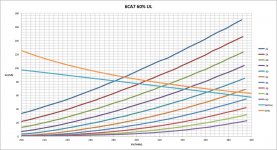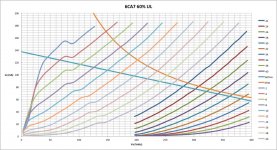Member
Joined 2009
Paid Member
Jacmusic has some charts in their KT88 page towards the bottom of it. I copied two of those here for a quick look.
First is for triode mode, second is for UL43%.
Very interesting to see these curves.
Triode curves are lovely, but can't say the same for the UL.
I don't like U/L and never have done.
That's why all my amps have switches for different output modes and one of the modes is U/L I switch over to U/L it lasts about 10 mins and gets switched out again.
I would go so far as to say all amps should have switches just so you can hear the difference. So you have to ask why was it/is it so popular?
Well you can't sell an amp with half the power against an amp with more in a shoot out can you..in the 60's tone was king...so where did the tone come from?
The same tone people come over to tubes/valves for..and ask the question how do you get the old valve sound..they don't realise if they heard it, it would be a shock...Old ain't always good...when the dewy eyes dry up and reality sets in..which only happens when you listen to other stuff and many don't listen to other stuff.
Perhaps U/L is just a way of not having components for a pentode supply? Smaller cheaper? and perhaps popular..? (how much is a tap on a transformer..)
Regards
M. Gregg
That's why all my amps have switches for different output modes and one of the modes is U/L I switch over to U/L it lasts about 10 mins and gets switched out again.
I would go so far as to say all amps should have switches just so you can hear the difference. So you have to ask why was it/is it so popular?
Well you can't sell an amp with half the power against an amp with more in a shoot out can you..in the 60's tone was king...so where did the tone come from?
The same tone people come over to tubes/valves for..and ask the question how do you get the old valve sound..they don't realise if they heard it, it would be a shock...Old ain't always good...when the dewy eyes dry up and reality sets in..which only happens when you listen to other stuff and many don't listen to other stuff.
Perhaps U/L is just a way of not having components for a pentode supply? Smaller cheaper? and perhaps popular..? (how much is a tap on a transformer..)
Regards
M. Gregg
Last edited:
I've dabbled with UL in an instrument amp, a Hiwatt DR506 bass amp. In the end I decided to go beam tetrode mode (6V6), since it sounded more edgy.
Since I'm an open loop guy, I haven't even considered hifi UL. If a tube had UL kind of curves on it's own, I'd never use it, so why use an UL connected pentode or beam tetrode.
Too clean for instruments, too distorted for open loop audio.
In it's time, UL was a pretty good deal I think. But like M Gregg pointed out, the objectives were different.
Since I'm an open loop guy, I haven't even considered hifi UL. If a tube had UL kind of curves on it's own, I'd never use it, so why use an UL connected pentode or beam tetrode.
Too clean for instruments, too distorted for open loop audio.
In it's time, UL was a pretty good deal I think. But like M Gregg pointed out, the objectives were different.
+1. . .
Since I'm an open loop guy, I haven't even considered hifi UL. If a tube had UL kind of curves on it's own, I'd never use it, so why use an UL connected pentode or beam tetrode.
. . .
I'm not specially an open loop guy and since most loudspeakers need to be damped, I close the loop 😎
UL is a kind of NFB, probably the worst.
Yves.
Triode curves are lovely, but can't say the same for the UL.
I agree with you! Graphs for other tubes are similarly unprepossessing.
But visual 'attractiveness' of Va-Ia graphs has little to do with amplifier performance. It is where these are crossed by a proper load line that matters, and that is not so easily visualised.
A better indication is given by distortion vs. output power which are available for several main-stream output tubes. One will find that at the power just before overload for triodes, the distortion is not very different than for U.L. - whereafter U.L. still has at least 40% more power to offer.
It may have been said (I did not reread the whole thread!) that the often offered facility for switching between triode and U.L. is largely a sales 'nod' to those desiring it. Optimal load impedances are not the same for the two topologies, nor often even bias points, etc.
Regarding the theme, reminding of the basic difference here (probably also already mentioned) should that be used to judge: Apart from the above, global nfb is also diminished with such a move, often bringing low order harmonic products to audible levels and improving the 'niceness factor'. That becomes a factor in subjective preference one way or the other. (This subject has been discussed elsewhere.)
UL sounds more than fine to me in a SE amp with 4.4% 2nd harmonic distortion.
Until I measured it I could not hear any distortion or predict what % value the distortion is.
You can't listen with your eyes, that is just nonsense.
Besides, if you own a HiFi tube amp you probably don't listen to music which is super compressed to the peaks like Death Metal or something.
Thus, occasional distortion at peaks is in not that bad with good dynamic music which is not always at the peak.
Until I measured it I could not hear any distortion or predict what % value the distortion is.
You can't listen with your eyes, that is just nonsense.
Besides, if you own a HiFi tube amp you probably don't listen to music which is super compressed to the peaks like Death Metal or something.
Thus, occasional distortion at peaks is in not that bad with good dynamic music which is not always at the peak.
Last edited:
What was the B+ voltage for those curves?
One expects some oddities when the plate V drops maybe 100V below the screen V.
One expects some oddities when the plate V drops maybe 100V below the screen V.
At -20 they sure look pretty, but go more positive up to 0v g1 and you'll see a not so pretty picture.Since I have a pair of 60% SE UL 5k OPTs lying around, and some spare 6CA7's I ran some tests today and I think the curves are visually quite pretty 🙂
But again, the picture may be deceiving and the amp may sound sweet.
What was the B+ voltage for those curves?
One expects some oddities when the plate V drops maybe 100V below the screen V.
B+ was 400V in this case
Where did you get an OPT with 60% UL tap? And why does the graph only focus on a narrow range of grid voltages?
Member
Joined 2009
Paid Member
Makes sense - the more feedback (60% is higher than 40%) the more the curves will become triode.
60% is the other side of 40%? OPT upside down?
😀 LMAO I never thought of trying reversing the primary to move the OP tap.
What does it sound like? in comparison to the normal way round? ie is it still pants?
LOL you might as well put a 100K pot across the primary and connect a 1K from the grid to the wiper and dial in the connection..😀
Regards
M. Gregg
Last edited:
60% is probably way more Triode to bother with tapping the OPT.
Just wire as Triode and be done with it.
Just wire as Triode and be done with it.
.
Just wire as Triode and be done with it.
What kind of triode?

Regards
M. Gregg
Where did you get an OPT with 60% UL tap? And why does the graph only focus on a narrow range of grid voltages?
Well..... it's a bit of an odd thing really. I purchased two Hammond 1628SEA's that should have a 40% tap, but when I measure across the primary using the wire colour codes according to the manufacturer, I get a 60% tap. In other words the inductance (large signal measured at 50Hz) between the B+ connection and the screen tap primary connection is larger than that measured between the screen and anode connection (17,4 and 6.4H approx IIRC). I don't know why, I guess they may have got the wire colours wrong?
Anyway, I used this in an EL84 SE amp for a bit and it sounds pretty good, and so had 2 C cores wound locally with a 60% tap to use permanently in the EL84 amp.
The curves come from the uTracer with k=0,6; Being new to the tube game I am just experimenting to get a better understanding what I am doing (or not doing for that matter). The focus on one range of grid voltages is simply to keep Ia below the uTracer's compliance level, otherwise there is a bit of post measurement data clean-up that has to happen.
Is anyone interested in lower grid voltages; I would not want to hijack the OP's thread.
It seems very likely that Hammond reversed the P and B wires.I don't know why, I guess they may have got the wire colours wrong?
That's odd, I thought you can set the Pdiss on the uTracer, plus Ia itself has a hard limit... anyway, it is just unusual to see UL characteristic bunched up like that.The curves come from the uTracer with k=0,6; Being new to the tube game I am just experimenting to get a better understanding what I am doing (or not doing for that matter). The focus on one range of grid voltages is simply to keep Ia below the uTracer's compliance level, otherwise there is a bit of post measurement data clean-up that has to happen.
The kind that sounds flat and un-unique...Solid State like?
I don't think so, but I am not an expert. It has quite a bright and (for me), detailed sound, one I enjoy for my application.
On the uTracer you can overlay the Pdiss on the curves, but I don't think that will stop the measurements when it reaches that level (I will still need to check that statement!)
Anyway, for interest, I did some more quick measurements down to Vg =-2V. Apologies that the graph is not tidied up, but the grid voltage is stepped by 2V starting at -2V
Attachments
- Status
- Not open for further replies.
- Home
- Amplifiers
- Tubes / Valves
- Why do some people dislike ultralinear?

